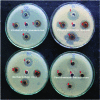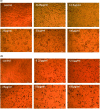Assessment of antioxidant, antibacterial and anti-proliferative (lung cancer cell line A549) activities of green synthesized silver nanoparticles from Derris trifoliata
- PMID: 30997029
- PMCID: PMC6430089
- DOI: 10.1039/c8tx00323h
Assessment of antioxidant, antibacterial and anti-proliferative (lung cancer cell line A549) activities of green synthesized silver nanoparticles from Derris trifoliata
Abstract
In this work, silver nanoparticles (AgNP-DTa) were prepared using an aqueous seed extract of D. trifoliata. The importance of the present piece of work is viewed specially with respect to ascertaining the potential of a widely distributed under-utilized mangrove associated plant, Derris trifoliata (DT), as medicine. The as-prepared AgNP-DTa were well dispersed and stabilised in aqueous solution through biological ligands extracted from the seeds of DT. The functional groups present in the bio-ligands of DT act as reducing and stabilising agents in the formation of nanoparticles. Besides, in the present work, sunlight could induce and catalyse the reduction process of Ag+ to its corresponding silver atoms of nanoscale dimensions. The size of AgNP-DTa decreased with an increase in the duration of sunlight irradiation. Bio-augmented nanoparticles were characterized by UV-vis spectroscopy, XRD, HR-TEM, DLS, AFM and photoluminescence measurements. Preliminary phytochemical studies and FTIR analysis confirmed the presence of secondary metabolites with hydroxyl, amine and carbonyl groups as reducing/capping agents. AgNP-DTa demonstrated high DPPH scavenging activity with an IC 50 value of 8.25 μg ml-1. Greater antioxidant activity of AgNP-DTa was also confirmed from total antioxidant capacity (TAC) assay where it was found that the reducing power of 1 g of AgNP-DTa is almost equivalent to that of 1.3 g of Trolox. In addition, highly stable AgNP-DTa showed antibacterial activities against Gram positive and Gram negative bacteria. The as-prepared AgNP-DTa were observed to inhibit the growth of Klebsiella pneumonia, Staphylococcus aureus and Escherichia coli and no clear zone was obtained for Pseudomonas aeruginosa. With reference to the anti-proliferative activities, AgNP-DTa exhibited moderate activity on A549 lung cancer cell lines with a median effective concentration of 86.23 ± 0.22 μg ml-1.
Figures








References
-
- Jain P. K., Huang X., El-Sayed I. H., El-Sayed M. A. Acc. Chem. Res. 2008;41:1578–1586. - PubMed
-
- Abdel-Aziz M. S., Shaheen M. S., El-Nekeety A. A., Abdel-Wahhab M. A. J. Saudi Chem. Soc. 2014;18:356–363.
-
- Kim J. S., Kuk E., Yu K. N., Kim J.-H., Park S. J., Lee H. J., Kim S. H., Park Y. K., Park Y. H., Hwang C.-Y. Nanomedicine. 2007;3:95–101. - PubMed
-
- Ahmed S., Kaur G., Sharma P., Singh S., Ikram S. J. Appl. Biomed. 2018;16:221–231.
LinkOut - more resources
Full Text Sources
Miscellaneous

